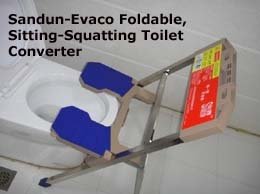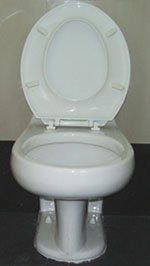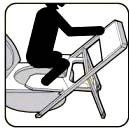|
Urinary Incontinence - A Silent Epidemic
It is a serious problem that has reached epidemic proportions. The extent of the suffering and high cost of treatment is reflected in these statistics (from Medicinenet):
But these figures do not give the full picture. For less than 50% who have problems with bladder control are too embarrassed to talk about it. The tragedy of it all is that urinary incontinence can easily be prevented because it has an underlying cause: sitting toilets.
Many doctors are still unaware of the connection between urinary incontinence and sitting toilets. This is due to cultural conditioning. It would be difficult for a doctor, living in a society where sitting toilets are the norm, to be able to accept it. Also, somehow, the information has been suppressed and kept from the public, for a good reason. Medical practice for urinary incontinence is extremely lucrative and has become a multi-billion dollar industry. The sale of adult disposable diapers alone is worth more than a billion dollars a year. Obviously, there are many companies which don't want this to change. With sitting toilets making huge inroads in many parts of the world today, the problem of incontinence is going to get worse. One can only hope that more people would learn about the toilet connection, and take action to protect themselves. There are three things about urinary incontinence which would have revealed its association with another serious ailment, pelvic organ prolapse.
SIDENOTE 1 Pelvic floor prolapse can be attributed to straining on a sitting toilet. The descent of the pelvic floor often results in urinary incontinence. (More on this later.) Women are more susceptible to urinary incontinence simply because their pelvic floor is more flexible (to allow for childbirth). This also explain why many women develop incontinence during pregnancy and after childbirth. (A detailed explanation on the connection between sitting toilets and pelvic floor prolapse is given in the
Pelvic Floor Prolapse
section.)
SIDENOTE 2 Squatting is the position designed by nature to protect the pelvic floor during delivery. Sadly, the long-term use of modern toilets has also rendered millions of women incapable of prolonged squatting. The explanation for this is given in the page on
squatting facets.
Adelaide University researchers, in the first comprehensive study of its kind in the world, have found a remarkably high prevalence of incontinence and pelvic prolapse in the Western countries. The results of the study were published in an article entitled
The Descent of Women – A Silent Epidemic (23 Nov 2000).

In an interview with the Australian Broadcasting Corporation (21 November 2005), Professor Ajay Rane, consultant urogynecologist and pelvic reconstructive surgeon from James Cook University also spoke about the prevalence of urinary incontinence and pelvic floor disorders: "Quite basic statistics even from India are showing that their incidence of incontinence or genital prolapse is far less than our population. Australia, like any Western culture at the moment, is going through what's called a silent epidemic of urinary incontinence and genital prolapse. As high as one in three women will suffer from urinary incontinence during their lifetime - this increases to one in two after the age of seventy. One in eleven women will have an operation for genital (pelvic organ) prolapse in their lifetime. Thirty percent of these women will have a repeat operation within two years, so it's a big problem that we are facing."

Sitting toilets increase the risk of urinary incontinence because users are forced to strain for waste evacuation. SIDENOTE On a sitting toilet, with the colon in the continence mode, a person is forced to strain while holding the breath and bear downwards with the diaphragm in order to evacuate waste
(the Valsalva Maneuver).
The effect of straining during bowel movements can be devastating on the pelvic floor. Each time a person strains, the pelvic floor is stretched and pushed downwards. Assuming that a person have to strain three times per day on a sitting toilet, by age 45, her pelvic floor would have been pushed and stretched 50,000 times. The pelvic floor is simply not equipped to take this kind of abuse. Over time, its muscles weakened, it can give way and cause a prolapse (dropping) of the pelvic organs (bladder, uterus, rectum, vagina). This is when the problem of urinary incontinence can arise. Passing through the pelvic floor, and connecting the bladder to the spinal cord, is the pudendal nerve which controls, among other things, bladder function. With the descent of the pelvic floor, the pudendal nerve can suffer a stretch injury, and lose its ability to properly transmit brain signals to and from the bladder. (More information on pudendal nerve.) Further proof that using the correct toilet posture is the natural remedy for incontinence can be found in the article "My Child, My Teacher" that was published in the 1998 spring edition of the New Vegetarian and Natural Health magazine. The article, which focused on the benefits of squatting for children, recorded numerous cases of bedwetting that was corrected by a simple change in their toilet posture (from sitting to squatting).
Conclusion More than any other factor (pregnancy and childbirth, hormonal changes due to menopause, medications etc), the high incidence of urinary incontinence is caused by wrong toilet posture. To quote Professor Ajay Rane...
The solution is actually very simple: to squat instead of sit for waste evacuation. In order to do this, you must be able to squat, and also have a squatting toilet. For those want to switch from sitting to squatting, the most common problem they will have is the lack of a squatting toilet. In such a case, a practical solution is to use a toilet squatting platform or converter.

You can find out more about Nature Knows Best by visiting this page.
Have A Great Story About This Topic?Do you have a personal account about the topic discussed on this page? Please consider sharing it. You can be sure that many people in the world would love to read about and greatly benefit from your experience. It's easy to do. Just let your words flow. Thanks for sharing! What Other Visitors Have SaidClick below to see contributions from other visitors to this page...
Gary Not rated yet
|
The Best Toilet Converter in The World Today!


Helping People All Over
The World Achieve
Good Health Through
Correct Toileting Posture
Watch video on the
origin and story of
the Sandun-Evaco
toilet converter
All about Life,
Hope and Truth...
FREE:
One of the most
astounding books
you will ever read
in your life!





 Professor Stuart Stanton, Chairman of the Continence Foundation and Consultant Urogynaecologist at St George's Hospital, London is also strongly in favor of using squatting toilets:
Professor Stuart Stanton, Chairman of the Continence Foundation and Consultant Urogynaecologist at St George's Hospital, London is also strongly in favor of using squatting toilets:




